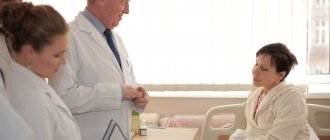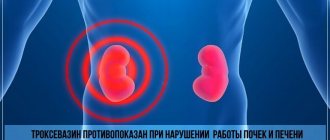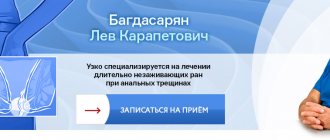The problem of hemorrhoids is quite common among people. It accounts for 35–40% of all rectal diseases. Ligation of hemorrhoids allows you to cope with it in 85% of cases.
Due to genetic predisposition, a sedentary lifestyle, and dietary habits, dilation of the veins of the hemorrhoidal plexus occurs in the anus. They take on the appearance of nodes: they are enlarged, painful, and blood clots can form in them. A person suffering from hemorrhoids notes prolapse of the nodes outside the rectum, which requires their reduction. When injured, they bleed, can become inflamed, and when pinched, ischemia and necrosis develop. With a long course of the disease, the surrounding intestinal mucosa suffers. It can ulcerate, become inflamed, and with frequent bleeding, anemia develops.
Treatment, removal of hemorrhoids - profile of the Alan Clinic medical center. Contact our specialists.
Briefly about the main thing
Ligation of hemorrhoidal nodes with latex rings is a minimally invasive non-surgical method, the mechanism of action of which is to mechanically compress the node’s stem in order to stop the supply of blood to the pathological element.
The technique is used for bloodless removal of internal hemorrhoids and is characterized by a short list of contraindications, minimal risk of complications and a short recovery period.
Before the operation, you should cleanse the intestines, and during the short rehabilitation period, adhere to a diet, observe a protective regime and take medications prescribed by your doctor.
The only drawback of the low-traumatic technique is its limited use. Ligation is not recommended for irreducible hemorrhoids, large and multiple elements, as well as complicated pathology. Therefore, you should contact a proctologist as early as possible!
Real help
Treatment of hemorrhoids is a problem that worries both the patient and medical proctologists. In 1958, foreign doctors proposed a new method of combating hemorrhoids. Its essence is to use a special device - a ligator. This device grabs the stem of the hemorrhoid and places a ring of latex on it, pinching the blood vessels. The hemorrhoid lump stops receiving nutrition and naturally dies.
Deprived of blood supply, the hemorrhoidal lump disappears 7-14 days after the proctologists’ actions. At the site of the nodes, a scar is formed, covered with connective tissue. Doping is a quick and effective help for people suffering from hemorrhoids.
The essence of the technique
Ligation with latex rings is used for radical treatment of internal uncomplicated hemorrhoids I-II, in some cases - stage III.
The essence of the method is mechanical disconnection of the node from blood supply by ligating its stem. Stopping the blood supply leads to the death of the node.
The nodes come off together with the applied ligature. This is an invisible, completely painless process for the patient.
Ligation of hemorrhoids with latex rings is a fairly effective method. To prevent the disease from returning, it is necessary to adhere to the rules of prevention.
Types of ligation of hemorrhoids
The details of the procedure differ depending on the type of device. Ligation of hemorrhoids can be:
- Mechanical - the ligator has a handle, a long tube with a piston and a cylinder at the end. The clamp grabs the assembly and pulls it inside the cylinder. The trigger is pressed, causing the piston to push the ring onto the leg of the assembly.
- Vacuum - the device draws in the tissue to be removed using a vacuum. To do this, a medical aspirator is connected to the ligator. Pulling the trigger releases the latex ring. The level of negative pressure is adjusted by the doctor.
- Suture – ligation of the hemorrhoidal artery under the control of an ultrasonic sensor. After suturing the vessel and the adjacent intestinal mucosa, the filling of the hemorrhoidal plexus with blood decreases. The nodes are fixed, so they don't fall out anymore.
Diagnostics
The main diagnostic procedure is endoscopic examination of the rectum (anoscopy). This method, absolutely harmless to the body, will provide a full amount of information: ___• the number of internal hemorrhoids, their size and location, ___• the condition of the intestinal mucosa, ___• the presence of complications and concomitant pathologies of the rectum
In cases where there is reason to suspect a pathological process in the overlying parts of the large intestine, colonoscopy is prescribed.
If the decision is made in favor of ligation, standard preoperative diagnostic tests (laboratory tests) are prescribed.
Contraindications
The ligation procedure will have to be postponed in case of acute inflammatory process, as well as in case of exacerbations of chronic diseases. Treatment is not carried out during the recovery period after serious illnesses, vascular accidents, injuries, or operations.
Ligation of the internal node is not indicated for combined (internal and external) hemorrhoids, as well as in cases where the underlying disease is accompanied by other pathologies of the rectum: ___• proctitis, ___• anal fissure, ___• polyps, ___• malignant intestinal tumors.
In addition, minimally invasive interventions are not prescribed for complicated forms of pathology (thrombosis, rectal fistulas, bleeding).
Interventions are carried out with caution in cases of blood clotting disorders, liver pathologies, diabetes mellitus, and severe pathologies of the cardiovascular system.
Are there any complications?
The first few days after ligation of the appendix are the most important. If the victim has mild pain, then this is quite normal, but if the pain is severe, you should consult a doctor. There is a possibility that the ligature was applied incorrectly. The same sensations are experienced by those people who have had several nodules ligated at once.
The most common type of complication is thrombosis of external nodes. A similar rule applies to those victims who have been diagnosed with a combined form of the disease. This means that the lesions do not have clear boundaries between internal and external components.
In such a situation, it is impossible to do without a course of conservative therapy depending on the circumstances. But only a proctologist should also prescribe medications, taking into account the current condition of the patient. Rectal bleeding is much less common. The reason for this is the rupture of the latex ring, or its tension is too strong.
Occasionally, the opposite principle leads to the same aftereffects - incorrectly selected size of the knot to support the installed ligature. This will become a catalyst for him to jump off during sudden attempts. Bleeding will also make itself felt if the patient goes against medical recommendations, deciding:
- engage in active sports;
- lift weights;
- empty your bowels according to the rules;
- ignore advice on maintaining personal hygiene;
- do not follow dietary restrictions.
To avoid bleeding during the first bowel movement, you will need to first cleanse the intestines. You will also have to try to avoid bowel movements on the first day by eating only something liquid like broth, juice, or yogurt.
In the following days, doctors insist that patients still soften their stools by eating appropriate foods. It should contain plant fibers and fiber. You also need to carefully monitor your own drinking regime.
To make healing go faster, you should stop sitting for long periods of time and also work on preventing constipation.
Some complications are a direct consequence of exposure to an infectious lesion. With such a development of the scenario, a person experiences pain, weakness, fever, and problematic urination.
If you notice any of the above symptoms, you should immediately consult a doctor to take emergency measures to counter the spread of infection.
Best materials of the month
- Coronaviruses: SARS-CoV-2 (COVID-19)
- Antibiotics for the prevention and treatment of COVID-19: how effective are they?
- The most common "office" diseases
- Does vodka kill coronavirus?
- How to stay alive on our roads?
Preparation
Preparation for the procedure begins 2-3 days in . It is necessary to stop taking medications that affect blood clotting (aspirin, ibuprofen) and switch to an intestinal-friendly diet.
The list of restrictions includes: ___• coarse vegetable fiber (cabbage, fresh vegetables and fruits), ___• legumes, ___• whole milk, ___• fatty foods, ___• sweets, ___• pickles, marinades, spices, ___• carbonated drinks, ___ • alcohol.
The day before your visit to the doctor, it is recommended to have an early light dinner and a light breakfast in the morning. Colon cleansing is carried out twice: in the evening and in the morning using the Microlax microenema.
Proctologists
Bagdasaryan Lev Karapetovich Surgeon - coloproctologist, candidate of medical sciences, doctor of the highest category, member of the Association of Coloproctologists of Russia.
Cost of admission 3500
₽
Make an appointment
Bagdasaryan Samvel Lvovich Surgeon - coloproctologist, candidate of medical sciences, member of the Association of Coloproctologists of Russia.
Cost of admission 2900
₽
Make an appointment
Technique
The procedure is performed with the patient lying on his side with his legs bent. The proctologist inserts an anoscope into the anus to, under visual control, apply an elastic hypoallergenic loop - a ligature - to the base of the node.
To carry out the operation, a special device is used - a vacuum ligator , with the help of which the pathological element is captured and a latex ring is put on it.
The manipulation is absolutely painless for the patient and therefore can be performed without anesthesia. The duration is less than an hour. At the end of the procedure, the patient can go home.
During one session, the doctor applies only one ligature. If there are several nodes, the procedure will have to be repeated. The interval between operations should be at least 1 week. Large formations are removed in stages. Your doctor will set a date for your follow-up visit.
Indications for ligation
The indication for ligation is internal hemorrhoids of stages 2 and 3, in which hemorrhoids significantly increase in volume and cause pain. The further course of the disease is characterized by:
- prolapse of hemorrhoids;
- systematic bleeding during bowel movements;
- pain, itching, burning in the anus;
- feeling of fullness in the rectum, etc.
Contraindications to ligation:
- HIV;
- Crohn's disease;
- taking Aspirin, Plavix.
Unpleasant consequences and methods of dealing with them
Unpleasant sensations
The most common side effect after applying a latex ring to an internal hemorrhoid is a sensation of a foreign body in the rectum. Medical measures are not indicated in such cases; over time, the intensity of the sensations decreases and does not cause concern to the patient.
pain may occur , the severity of which depends on a number of factors (the size of the node, its location, the characteristics of the patient’s individual sensitivity).
Pain should be relieved using medications recommended by your doctor. In case of resistant (constant) pain syndrome, you should consult a specialist, since pain can be a symptom of the development of complications.
Blood clot formation, bleeding, inflammation
___1. Blood clot formation is a very rare complication. The actions of doctors will depend on the situation: both conservative and surgical treatment may be prescribed. ___2. Sometimes such an unpleasant side effect occurs as staining of stool with blood . Most often, blood in the stool appears during the natural passage of a pathological element. Less commonly, the symptom indicates injury to the node with feces and/or the development of complications. If severe bleeding occurs, you should immediately consult a doctor. ___3. Inflammatory processes during minimally invasive interventions are extremely rare. As a rule, an infectious-inflammatory process occurs as a result of trauma to the nodule with solid feces, so to prevent complications it is necessary to adhere to a diet.
Latex ring slipping
Premature slippage of the latex ligature is a fairly rare complication that will invalidate the result of the operation. As a rule, the cause of slipping is excessive physical effort (weight lifting, sports, straining due to constipation). If this happens, contact your healthcare provider to have the procedure repeated.
Treatment of hemorrhoids using the latex ligation method
At one time, a special device was developed abroad, with the help of which a circular ligature made of special latex rubber is placed on the stem of the hemorrhoidal node. After squeezing the leg and stopping the blood flow to the node, it is rejected along with the ligature on days 11–14 after manipulation. As a result of the gradual cutting through of tissue with an elastic ligature after its rejection, a stump is formed, covered with connective tissue.
Ligation of hemorrhoids is performed for patients with the second and third stages of hemorrhoids. At the first stage, due to the lack of expression of the hemorrhoids, this procedure is not performed. In some cases, the procedure can be performed at the fourth stage of the disease, that is, with constantly prolapsed hemorrhoids, but with clearly defined boundaries, without pronounced external hemorrhoids.
In the absence of clear boundaries between the external and internal hemorrhoids, ligation is considered inappropriate. The absence of boundaries between external and internal hemorrhoids, as is the case with combined hemorrhoids, complicates and limits the application of latex ligatures. Contraindications for ligation of internal hemorrhoids are inflammatory diseases: anal fissure, chronic paraproctitis, proctitis in the inflammatory phase.
Method of ligation of hemorrhoids with latex rings
Ligation of hemorrhoids is carried out on a gynecological chair with the patient in the supine position with the legs adducted to the stomach or on the left side. An anoscope is inserted into the rectum. The anoscope is fixed with the left hand so that the anorectal line is covered by the edge of its tube, and the hemorrhoidal node is located in its lumen. Ligation of hemorrhoids with latex rings can be carried out using two methods.
In the first, a mechanical ligator is used, when the hemorrhoid is pulled into the working head of the ligator using a soft clamp.
A mechanical ligator with an elastic ring is inserted into the lumen of the anoscope until it comes into contact with the hemorrhoid. Use a soft clamp to grab the top of the hemorrhoidal node and pull the node into the head of the ligator, then press the trigger of the device that releases the ligature. The latex ring compresses the stem of the hemorrhoid. Before removing the device from the anoscope, remove the clamp from the node and check the position of the latex ligature on the stem of the hemorrhoid. The ring should only compress its pedicle, without capturing the tissue located below the dentate line.
With the technique worked out, the entire procedure takes 7-10 minutes. It is most convenient to use a mechanical ligator for internal hemorrhoids with clear boundaries and a well-defined pedicle located at least 5 mm from the edge of the pectineal line.
The essence of the second technique is as follows. Through the anoscope, a special vacuum ligator connected to a suction unit to create negative pressure is brought to the hemorrhoidal node protruding into the lumen of the anoscope. Use the foot pedal to turn on the suction and close the hole in the ligator with the thumb of your right hand to create negative pressure in the head of the instrument. Due to negative pressure, the hemorrhoidal node is pulled into the head. When a negative pressure of 0.7-0.8 atmospheres is reached, using a trigger mechanism, for greater reliability, two latex rings are dropped onto the hemorrhoidal node and the thumb is released from the hole on the ligator, equalizing the external pressure and the pressure in the head. Then the ligator is removed from the intestinal lumen. Removing the ligator without equalizing the pressure is fraught with rupture of the hemorrhoid and bleeding.
Both methods use elastic rings made of natural rubber (latex), with an outer diameter of 5 mm and an inner diameter of 1 mm. The peculiarity of the latex ring is good elasticity and gradual compression of tissues with gradual intersection of the hemorrhoidal pedicle over 12-14 days.
The vacuum ligation technique is simpler and more convenient than the mechanical ligation technique. In particular, when using a vacuum ligator, there is no need to use an assistant during the manipulation. In addition, the vacuum ligation technique is used not only in cases with a clearly defined pedicle of the hemorrhoid, but also in cases of circular internal hemorrhoids, when it is quite difficult to determine the pedicle of the node. If the procedure is performed technically correctly, the elastic ligature compresses the leg of the knot and is located 5-7 mm above the dentate line.
The procedure for ligating internal hemorrhoids in one patient is usually carried out in two, three (most often) or more sessions. It is best to ligate one hemorrhoid in one session.
Sometimes it may be necessary to carry out additional (repeated) ligations in the case of fairly large hemorrhoids, the size of which does not allow the node to be completely captured at one time by the head of a vacuum ligator; in this case, re-ligation of the hemorrhoid should be carried out no earlier than a month later.
Results of ligation of hemorrhoids with latex rings
Ligation of hemorrhoids with latex rings avoids hemorrhoidectomy in approximately 80% of patients with hemorrhoids.
All procedures are performed on an outpatient basis, without disability. In the vast majority of cases, the use of this technique in the 2nd and 3rd stages of the disease allows one to achieve good results - stopping the bleeding and prolapse of hemorrhoids.
At stage 4, it is advisable to use the ligation technique with latex rings only in patients with clear boundaries of prolapsed nodes.
During the first two days after ligation, most patients note a feeling of a foreign body in the anal canal and mild pain, which is relieved by non-narcotic analgesics. These phenomena are not considered complications; they are associated with compression of the hemorrhoidal pedicle and do not require special treatment.
Possible complications:
- Pain syndrome.
- Thrombosis of external hemorrhoids.
- Rectal bleeding.
In some cases, after a ligation session, the patient may experience pain. In most cases, severe pain occurs after simultaneous ligation of three hemorrhoids and due to the application of a ligature to the pedicle of the hemorrhoid at the level of the pectineal line, i.e. in the anus area, which is equipped with pain receptors. To avoid the occurrence of severe pain, it is necessary to strictly follow the rule of stage-by-stage ligation of hemorrhoids with an interval between procedures of at least 14-16 days.
If a sharp pain syndrome occurs that persists for 1-2 hours and is not relieved by non-narcotic analgesics, the patient undergoes repeated anoscopy, the applied ligature is cut with narrow scissors and removed.
It should be remembered that the retraction of the hemorrhoid into the ligator must be done gradually and always under the control of the eye, so that the ridge line does not fall into the latex ring. If persistent pain occurs that is not relieved by analgesics, immediately after ligation and if it is suspected that tissues of the anal canal located distal to the dentate line have entered the ligature, the latex ligature is cut through the lumen of the anoscope with narrow scissors and removed from the rectum.
In some cases, after a ligation session, the patient may experience thrombosis of external hemorrhoids. The occurrence of this complication is usually due to; that this procedure is performed in patients with a mixed form of hemorrhoids, in the absence of boundaries between the external and internal nodes. In most cases, thrombosis of hemorrhoids can be managed with conservative measures.
In the presence of diseases such as anal fissure and chronic paraproctitis, the ligation procedure should be abandoned until they are cured.
In approximately one case out of a hundred, after ligation, rectal bleeding is possible, requiring emergency measures. Most often, such bleeding occurs due to an inaccurate choice of indications for the ligation procedure (performing ligation for unexpressed hemorrhoids, after which the mass of the hemorrhoid may not be enough to hold the ligature - it can come off during straining) or due to the patient’s failure to comply with medical recommendations on limiting physical activity, normalizing bowel movements, nutrition and hygiene.
The cause of bleeding can also be ligation with one latex ring. When straining, due to too much tension, the latex ring may rupture and bleeding may develop. Therefore, it is advisable to perform ligation with only two latex rings, especially in patients with large hemorrhoids.
Bleeding may also occur after bowel movements on the first day after the procedure. Therefore, before the procedure, it is necessary to prepare the colon with the same care as for hemorrhoidectomy, and patients should be warned about undesirable bowel movements on the first day after the procedure.
The results of treatment allow us to consider ligation with latex rings as an effective and radical method of treating hemorrhoids.
- -Haemorrhoids
- -Hemorrhoids - Causes of occurrence
- -Hemorrhoids - Symptoms, clinical course
- -Hemorrhoids - Classification and types
- -Hemorrhoids - Diagnosis
- -Choice of treatment method for hemorrhoids
- -Hemorrhoids: conservative therapy
- -Hemorrhoids: infrared coagulation (IRC)
- -Hemorrhoids – Sclerotherapy
- -Hemorrhoids - Desarterization
Recovery period
Protective regime and hygiene procedures
All ongoing rehabilitation measures are aimed at speedy healing of the wound and prevention of complications: ___• In the first days, it is necessary to limit physical activity. You cannot lift weights exceeding 5 kg or visit the sauna. ___• A week after surgery, moderate physical activity is allowed: swimming and race walking. ___• The ban on strength sports and heavy physical labor remains in effect for a month. ___• Perineal toileting is carried out as usual (twice a day, morning and evening).
Diet food
The vast majority of complications after ligation surgery occur as a result of injury from solid feces. Therefore, it is necessary to exclude from the menu products that have an irritating and strengthening effect: ___• semolina porridge, rice, ___• potatoes, ___• legumes, ___• spicy and smoked dishes, ___• baked goods made from wheat, ___• carbonated drinks, ___• alcohol.
It is necessary to observe the temperature regime: you should not eat too hot or too cold foods. The optimal solution is warm, soft food: stewed, boiled, pureed (fried and smoked foods are strictly prohibited).
In order for the rehabilitation process to proceed at a normal pace, adequate nutrition is necessary: dietary meat, poultry, fish, boiled or stewed vegetables, and fermented milk products.
Medication support
To prevent complications of hemorrhoid ligation, proctologists prescribe drugs from several groups.
Painkillers from the group of non-steroidal anti-inflammatory drugs reduce the severity of pain and inhibit the inflammatory response. Such drugs are prescribed orally (Nurofen, Ketanov).
To avoid injury from hard feces, take stool softening laxatives (for example, Forlax).
How to protect yourself from relapse
Ligation of hemorrhoids is a reliable treatment method. However, if the patient is predisposed to developing this disease, hemorrhoids may recur.
To prevent a relapse, you should minimize the number of factors contributing to the development of pathology: ___• normalize stool, ___• get rid of excess weight, ___• give up spicy food and alcohol, ___• avoid prolonged sitting, ___• limit severe physical activity exercise, visiting a bathhouse, sauna, ___• it is recommended to engage in physical therapy, ___• promptly treat diseases of the gastrointestinal tract and genitourinary system.
Statistical data show that if all recommendations are followed, the relapse-free period after ligation of nodes can last indefinitely (10-15 years or more).
Preparatory activities and rehabilitation
Ligation of internal hemorrhoids (the procedure is not suitable for external ones) does not require specific preparation or hospitalization. You can prepare for the procedure at home or undergo a comprehensive examination in a hospital. Mandatory diagnostic methods: ECG, anoscopy, colonoscopy, a number of laboratory tests. Preparatory activities at home:
- Follow a therapeutic diet, avoid fatty and fried foods, fast food, soda and alcohol.
- Temporarily stop taking anticoagulants and other drugs that interfere with blood clotting.
- In the morning before the procedure, perform a cleansing enema or cleanse the intestines using laxative suppositories.
- Perform a hygienic procedure for the perineum, and then go to an appointment with a proctologist.
The procedure lasts up to 20 minutes, after which the patient remains under medical supervision for another couple of hours. For a speedy recovery, it is important to follow the following medical recommendations:
- adhere to a therapeutic diet;
- take painkillers and anti-inflammatory drugs, antibiotics if indicated;
- after a few days, enrich your daily diet with fiber-rich foods;
- drink more fluids, maintain water balance up to 2.5 liters of water per day;
- If you have difficulty defecating, take laxatives.
In addition, it is important to be vigilant and monitor the condition of the anorectal area, to exclude massive bleeding and displacement of the latex ring. If you feel acute pain after ligation, immediately contact a proctologist.
Is it possible to postpone the operation?
Ligation of hemorrhoids is a planned procedure that can always be postponed. Even gentle interventions must be carried out against the backdrop of physical and psychological well-being.
However, it should be taken into account that chronic hemorrhoids are prone to the development of complications such as: ___• thrombosis and bleeding of the node, ___• infectious and inflammatory complications (proctitis, paraproctitis), ___• anal fissure.
At the stage of irreducible hemorrhoids, with large and/or multiple nodes, as well as in the event of complications, doctors will be forced to abandon low-traumatic treatment methods in favor of traditional surgery (hemorrhoidectomy).
A long course of chronic hemorrhoids, accompanied by bleeding, leads to anemia, physical and nervous exhaustion.









